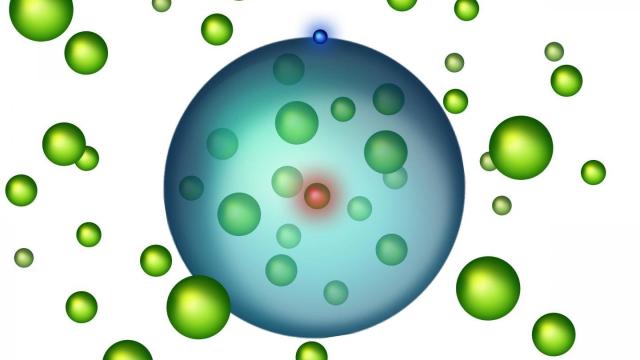Some of the most exciting, mind-blowing physics happens when things get really, really cold – such as atoms clumping beneath the shell of a far-out electron. Imagine a bunch of people huddled under an awning, except the people are atoms, and the awning is… also an atom.
This new assemblage, recently discovered by an international team of physicists, has a name: the Rydberg polaron. You’re not going to see it in a weapon or fuel any time soon, but it definitely subverts some pretty basic understanding of how atoms behave.
“It’s not the stuff you learn in chemistry,” study author Thomas Killian, physicist at Rice University, told Gizmodo. “It’s a new mechanism that’s only been studied in the last five or so years.”
Ultra-cold temperatures slow atoms to a near standstill, and can bring out some strange and important physical properties (like four dimensional effects, time crystals and supersolids, to name a few). These atoms, like all atoms, appear as central nuclei surrounded by electrons. You can’t determine exactly where an electron is; these particles are arranged into a series of most likely locations, organised from the least to most energy required to get there. It’s almost like the electron smears out into a cloud, taking up the space of these energy levels.
In this experiment, researchers cooled a collection of strontium atoms to just above absolute zero with a laser. They gave a single atom some extra energy, pushing the electron to a very high-energy state, called a Rydberg state, where the electron’s likely location is far away from the nucleus. The researchers watched as the electron shepherded in nearby strontium atoms, creating the Rydberg polaron, according to the paper published recently in Physical Review Letters.
At least one outside researcher who studies cold molecules, Hannah Williams from Imperial College London, told Gizmodo it was a cool-sounding experiment. “I think the demonstration of moving between few and many-body physics regimes is very cool to see,” she said.
The researchers told me that this study functions mainly as basic science – to understand the very nature of the atoms that make up our world. After all, the Rydberg polarons only exist for a few microseconds. But this behaviour could have important implications and even help make some other physics measurements.
Particles come broadly in two flavours, either “bosons” or “fermions.” Bosons don’t mind sharing the exact same physical state with other bosons, and tend to clump. Fermions are forbidden from sharing states and always stick around on their own. If you’re a physics fan, you may have already guessed that these strontium atoms made up a Bose-Einstein condensate — a gas of super-cold bosons demonstrating this signature clumping, amplifying the weird effects of quantum mechanics on a larger scale. Killian explained that he was interested in looking at the behaviours of these systems using fermions instead — what happens if the atoms won’t clump?
And aside from basic science, Killian pointed out that other systems relying on these Rydberg atoms, like some quantum computer architectures we’ve written about, might need to consider whether the atoms will form Rydberg polarons in the future.
Those concerns about quantum computers won’t be important for a while, since that technology is so nascent. But for now, researchers have demonstrated a truly weird behaviour in these cold atomic systems. “We have a completely new kind of atom where one electron runs around many atoms – within the orbit of one nucleus there are hundreds of other atoms,” study author Joachim Burgdörfer from TU Wien in Austria told Gizmodo. “This is a very exotic picture different from the planetary model of the atom you learn about in high school.”
[PRL]
